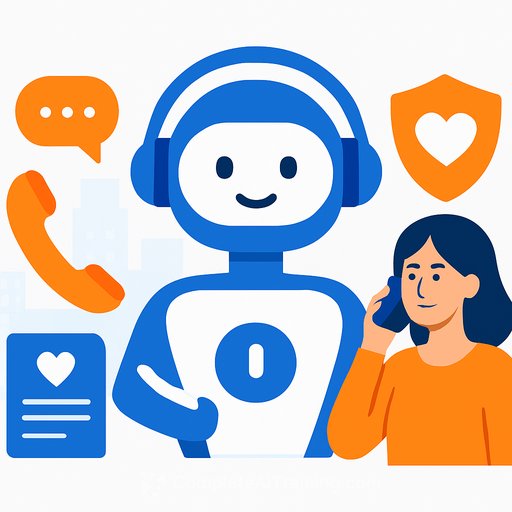Will businesses get lost in AI translation?
AI can now pick up the phone, speak multiple languages, and handle support queues without a break. The promise is simple: faster service, lower costs, and global coverage. The risk is just as clear: broken context, eroded trust, and brand damage at scale.
If you lead or work in customer support, your job isn't to resist AI. It's to deploy it with precision. Use it where it helps, guard the edges where it hurts, and measure everything.
Why AI translation is on every roadmap
Leaders are betting big on AI handling live support. Sam Altman has said phone- and chat-based customer support roles are likely to be automated. Salesforce cut support headcount and says its Agentforce bots should handle roughly half of customer conversations soon.
Tools are improving fast. Google rolled out Gemini Enterprise with video translation, pitching tone and expression capture. Salesforce announced Agentforce Voice with tunable tone, speed, and pronunciation. Bret Taylor's Sierra says AI agents can "pick up the phone."
There's momentum. But adoption isn't a straight line.
Where AI translation works today
- High-volume, low-risk FAQs: order status, refunds within policy, password resets, shipping timelines.
- After-hours and overflow coverage: triage, callback scheduling, case creation with clean notes.
- Simple troubleshooting that follows a script: step-by-step flows with limited ambiguity.
- Internal assist: live translation for agents and drafting multilingual follow-ups for human review.
Where it tends to break
- Ambiguity and nuance: idioms, sarcasm, emotion-heavy phrasing, and culturally loaded expressions.
- High stakes: cancellations with penalties, legal or medical matters, compliance disclosures, financial disputes.
- Context carryover: long histories across channels; pronouns and references get muddled.
- Brand voice: apology tone, escalation language, and empathy that doesn't feel canned.
Researchers reported that up to 47% of contextual meaning can be lost in conventional machine translation, especially around cultural and historical depth. Real-world government use has shown misinterpretations like "I" becoming "we," which can produce unfair outcomes. Now put that in a business setting-billing issues, identity verification, or contract terms-and the risk is obvious.
What customers actually want
Convenience is valued, but not at the cost of feeling unheard. A recent Kinsta survey found almost half of consumers would cancel a service if forced to deal with AI-only support. Over 40% say support has gotten worse with AI, and a similar share would pay more to avoid AI agents.
Translation: automate the right layers, but keep human lanes open and obvious. If it feels like cost-cutting at the customer's expense, you'll lose them.
Source: Kinsta survey on AI customer service.
A practical rollout plan for multilingual AI support
- Map intents by risk. Label each intent Low, Medium, or High risk. Start with Low.
- Choose the right modality. Voice for speed; chat for clarity; email for accuracy and auditability.
- Design guardrails. Do-not-translate glossary, brand tone presets, escalation triggers, and restricted actions.
- Human-in-the-loop. Require human review for Medium/High risk, sensitive intents, or low-confidence scores.
- Two-pass translation. Translate customer speech to your base language for reasoning; draft reply in base language; translate back to the customer's language. Check named entities.
- Clear escape hatches. "Press 0 for a human." Prominent handoff buttons in chat. No dead ends.
- Pilot by market. Launch in one language pair, one channel, one queue. Set hard success thresholds before expanding.
Quality standards you can measure
- CSAT/NPS by language. Track separately. Compare to native-language baselines.
- First contact resolution. Watch for drops in multilingual flows.
- Escalation and callback rates. Spikes point to mistranslation or policy gaps.
- AHT and silence time (voice). Long pauses mean slow or uncertain translation.
- Error review. Monthly audit of mis-translations, brand tone misses, and policy violations.
- Glossary hit rate. Ensure product names, legal terms, and brand phrases stay intact.
Safety, compliance, and brand checklist
- PII handling. Mask sensitive data in prompts and transcripts. Set retention rules.
- Consent and disclosures. Inform callers when AI is used. Offer human option without friction.
- Regulatory alignment. Payment flows (PCI), health data (HIPAA), and regional data laws (GDPR) need explicit controls.
- Liability boundaries. No legal, medical, or financial advice without approved scripts and human review.
- Accessibility. Accents, speech rates, and dialects should be configurable. Provide text alternatives.
When to use AI translation vs. human agents
- Use AI for structured FAQs, policy-locked tasks, simple troubleshooting, and after-hours triage.
- Use augmented AI to assist humans with real-time translation, drafting replies, and knowledge lookups.
- Use humans for escalations, complex troubleshooting, complaints, refunds outside policy, and anything with legal or reputational risk.
Tooling snapshot
- Google Gemini Enterprise: video and voice translation with tone control. Good for content and asynchronous support. Product overview
- Salesforce Agentforce Voice: voice handling with tunable tone, speed, and phonetic rules; English live with more languages in beta.
- Sierra: voice-first AI agents focused on transactional calls.
Implementation nuances that matter
- Pronunciation tables. Define phonetics for names, SKUs, and acronyms to prevent embarrassing reads.
- Dialect testing. Spanish (MX vs. ES), Portuguese (BR vs. PT), Arabic dialects, Farsi vs. Dari-test with native speakers.
- Emotion handling. Map sentiment to actions: escalate, slow down, summarize, confirm next steps.
- Summary-first recaps. Always close with a short summary and explicit confirmation in the customer's language.
Team skills to invest in
- Prompt and policy design. Turn support policies into structured, enforceable instructions.
- Conversation QA. Multilingual spot-checks, dataset curation, and bias review.
- Analytics for support. Read the signals: confidence scores, refusal rates, and intent drift.
Want structured upskilling paths for support teams working with AI? Explore role-based options here: Complete AI Training - Courses by Job.
A simple decision test before you replace any queue
- If the cost of being wrong is high (legal exposure, churn risk, press coverage), keep a human in the loop.
- If the task is repeatable, low-risk, and documented, automate and monitor.
- If customers are upset or confused, escalate to a human fast. Don't debate sentiment.
- If you can't measure quality, you can't responsibly deploy. Delay until you can.
Bottom line
AI translation can scale multilingual support and cut wait times. It can also misread context and burn trust in seconds. Both things are true.
Win by drawing bright lines: automate the simple, supervise the tricky, and make it effortless to reach a human. Set quality bars, publish them internally, and don't expand until you hit them consistently. That's how you get the benefit without getting lost in translation.
Your membership also unlocks:






